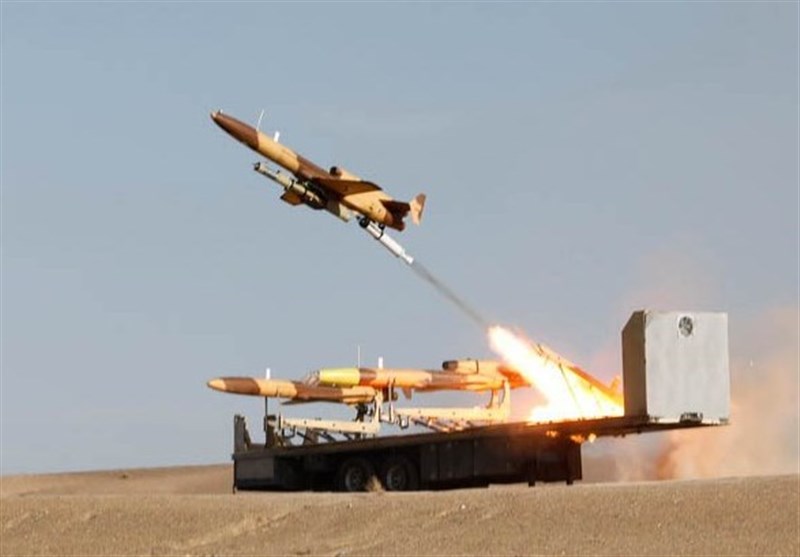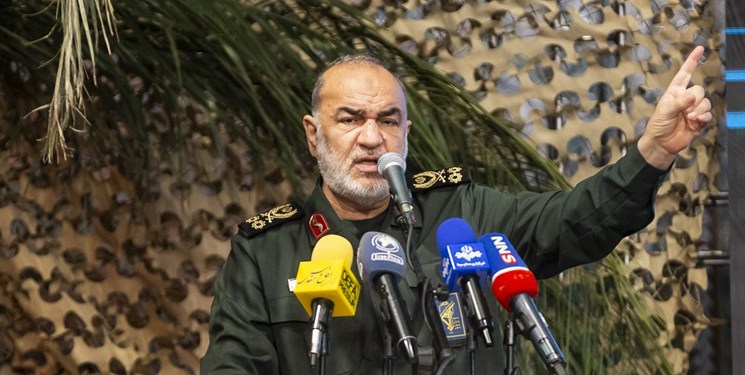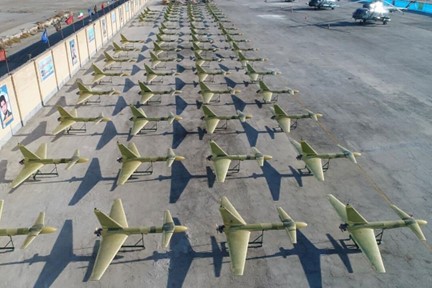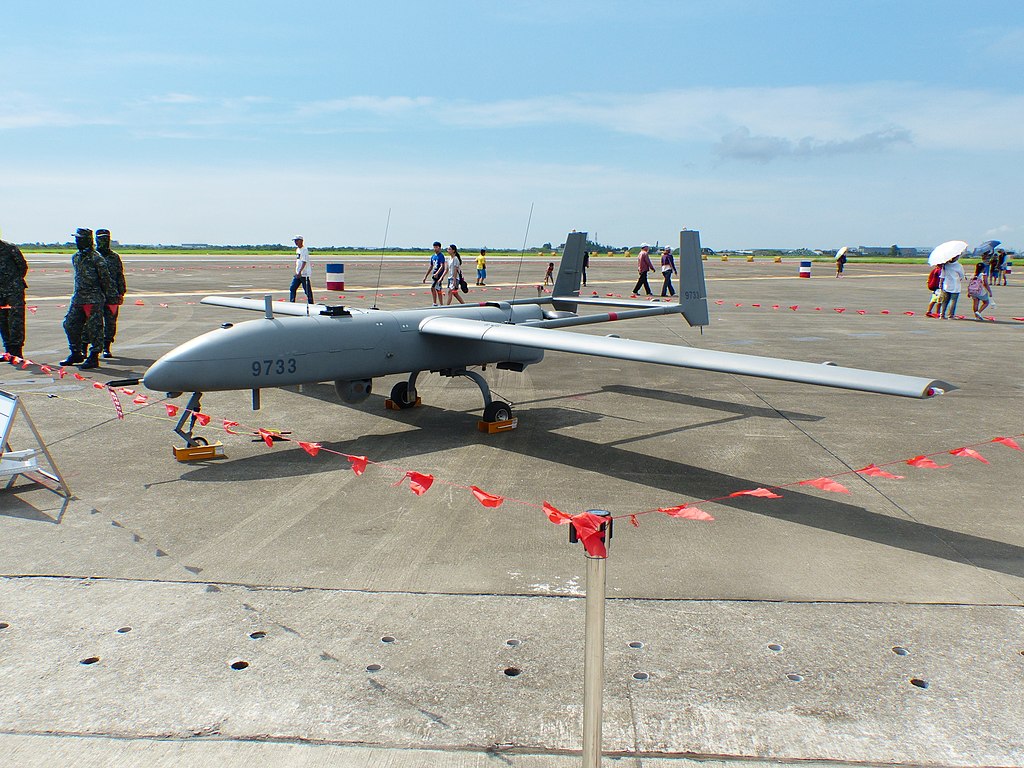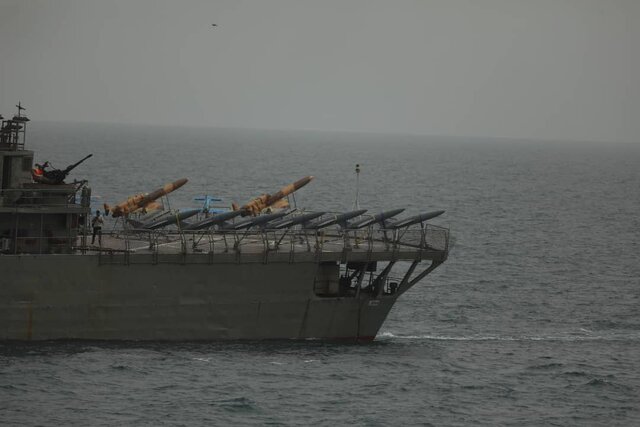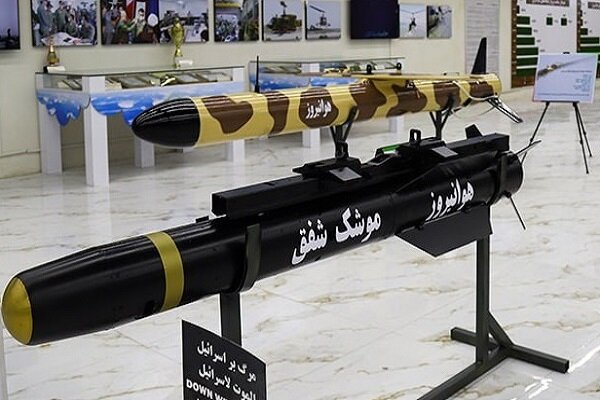
The Shafagh missile on display. The sign at the bottom reads “Death to Israel” in both Persian and Arabic.
“Iran is among the four countries with hypersonic technology.”
In the wake of simulated test fires and direct strikes on Israel, the semi-official Iranian news outlet Mehr News Agency highlighted the previous year’s missile developments. The Mehr News Agency article states some of Iran’s missiles are short-range, deployable on helicopters, and designed for use both on land and at sea. This reflects Iran’s growing military capability in the Persian Gulf and over the rough terrain of the Makran Coast, once a relatively lawless backwater whose strategic importance has grown as Iran seeks to develop a greater footprint in the northern Indian Ocean. The article suggests that Iran is focused on the development of smart weapons capable of identifying new targets while en route rather than simply being point-and-shoot. Such claims likely reflect actual progress, as the Iranian military has succeeded in developing all-weather GPS guided drones. The article also describes the Khorramshahr-4 missile in greater detail than others in its arsenal, a possible indication that Iranian reports regarding the Khorramshahr-4’s ongoing development may be accurate. Given its touted range and the explosive power of its warhead, deployment of the Khorramshahr-4 in large numbers could significantly change the operational environment across the region. The Persian Gulf, northern Indian Ocean, Red Sea, and Eastern Mediterranean, are within range and could be targeted although it is unclear if it would be successful against Israeli missile defense. The article reflects Iran’s aspirations to build the weapons necessary to alter the region’s decades-long status quo.
OE Insight Summary:
IRN continues to diversify its missile arsenal and extend their range and capabilities. Even if IRN claims about hypersonic capability are false, the IRN missile threat now extends from the Eastern Mediterranean to the Indian Ocean.
Sources:
” دستاورد موشکی در سال ۱۴۰۲ ۸”(Eight Missile Achievements in Year 2023-24),” Mehr News Agency (semi-official news agency owned by Iranian government’s Islamic Development Organization), 21 March 2024. https://www.mehrnews.com/news/6057908
In Persian year 1402 [20 March 2023 – 19 March 2024], developments in the missile field experienced a glorious period. In this year, we revealed several strategic and precision missiles, such as the hypersonic “Fatah,” the “Paveh,” and the ballistic Khorramshahr-4.
Below we briefly examine the capabilities of some of the most important indigenous missiles unveiled during the Persian year:
- Shafagh Missile: On 4 January 2024, Maj. Gen. Sayyed Abdolrahim Mousavi, commander-in-chief of the Islamic Republic of Iran Army, presided over a ceremony unveiling the upgraded Shafaq missile. The Shafaq missile is accurate up to a range of 12 miles.[i]
- Qadr-29: On the same day, the Qadr-29 missile system with a range of 100 miles, equipped with four-kilogram warheads, was also unveiled. It is used in suicide and reconnaissance operations. This missile system can also be installed on all types of [Bell] 206 helicopters….
- Haider Cruise Missile: The commander-in-chief of the army also unveiled the Haider long-range cruise missile. This missile system can also be installed on most helicopters equipped with heat-seeking warhead with a range of 120 miles…. Thus system is able to target all land and sea targets in difficult mountainous terrain, sea coasts, and sandy and desert areas with minimum time and with maximum surprise….
- Talaiyeh and Nasir Cruise Missiles. The Talaiyeh missile system was added to the regular navy this past year. This missile has a range of more than 600 miles and is smart, with the ability to autonomous detect and adjust to new targets during its flight…. The Nasir Maritime Cruise Missile was deployed to the third maritime zone this year. It is a smart missile with a range of 60 miles, and it has very high destructive capability….
- Paveh Cruise Missile. On 22 September 2023, the long-range Paveh ground cruise missile was unveiled during an armed forces’ parade near the Holy Shrine of Imam Khomeini.
- Hypersonic Fattah Missile. On 6 June 2023, the Islamic Revolutionary Guard Corps’ Aerospace Force was unveiled at its headquarters in the presence of President Ebrahim Raisi, Islamic Revolutionary Guard Corps Commander-in-Chief Maj.-Gen. Hossein Salami and Revolutionary Guard Aerospace Force Commander General Amir Ali Hajizadeh. With the unveiling of this missile, Iran became one of the four countries with this technology…. Hajizadeh stated at the ceremony of the unveiling of the hypersonic Fattah missile, stated, “The missile that was unveiled today is a missile that is unique in the world, so that with the launch of this missile Iran is among the four countries with hypersonic technology….”
- Khorramshahr-4 Long-Range Strategic Missile. The Khorramshahr-4 long-range strategic missile was another missile unveiled in 2023-24. On 25 May 2023, on the anniversary of the liberation of Khorramshahr [during the Iran-Iraq War], the Khomrramshahr-4 long-range strategic missile was unveiled in the presence of Minister of Defense Mohammad-Reza Gharaei Ashtiani. The Khorramshahr missile is one of the most advanced missiles designed by experts of the Aerospace Organization of the Ministry of Defense. It has a range of 1,200 miles and is equipped with a severe blast type combat head weighing 3,300 pounds. The rocket is equipped with one of the most advanced liquid fuel engines to create tactical capabilities and is designed in such a way that the engine is placed in a fuel tank, which reduces the length of the rocket to about 40 feet
- Fattah-2 Hypersonic Missile. On 19 November 2023, His Excellency Ayatollah Khamenei, the commander-in-chief, visited Ashura University of Aerospace Sciences and Technologies for an hour and a half to see the latest achievements of the Islamic Revolutionary Guard Corps. In this exhibition, which included missile, drone, defense and space products, young scientists from the Aerospace Force displayed their achievements under the slogan, “From Idea to All-Iranian Product.” … [Here,] the Fattah-2 hypersonic cruise missile, classified as a hypersonic glide vehicle was unveiled.
Notes:
[i] For previous discussion of the Shafagh, see: Michael Rubin, “Iran Installs New Precision Missiles On Army Helicopters,” OE Watch, 05 2023. https://fmso.tradoc.army.mil/2023/iran-installs-new-precision-missiles-on-army-helicopters/
Image Information:
Image: The Shafagh missile on display. The sign at the bottom reads “Death to Israel” in both Persian and Arabic.
Source: https://media.mehrnews.com/d/2024/02/03/3/4842101.jpg?ts=1706943630686
Attribution: Mehr News Agency

